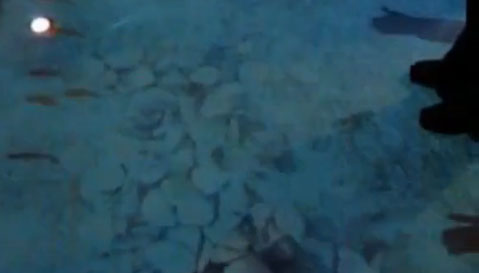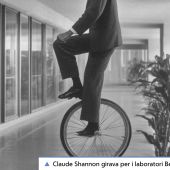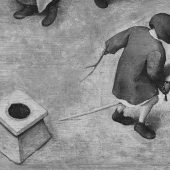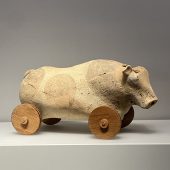From a draft version of a chapter for Michelle Henning’s forthcoming collection on Museum Media. Accompanying video is here.
Occupying the final room of the centre, visitors entered the installation after walking through a range of natural history and ecological displays, from living animals in vitrines to interactive screens and videos. Visitors enter a smallish dark room. A data projector suspended from the ceiling projects directly down onto the floor. The floor is transformed into a shallow rock pool or river bed and visitors, as they walk across it, the clear blue water under their feet. It quickly becomes apparent that this virtual water responds to the visitors / players’ footsteps, rippling and bubbling in a simulation of turbulence. The overall experience is effective, the simple device of rotating the conventional vertical orientation of the screen 90 degrees transforming the now familiar experience of the museum interactive screen into something different – a playful augmented reality, the visitors themselves inhabiting a coherent space with the virtual shallows through which they paddle.
Stand still for a moment and small schools of computer-generated fish flit out from the edges of the projection. As with the rippling water it takes a minute or so to realise that they too are responding to the movements of the visitors. They swim towards a visitor’s feet, but any movement of the visitor’s body sends them flitting away again. A relatively simple mechanic of motion detection and Alife algorithms – of ‘flocking’ this time, the simulation of the complexity of flocks of birds or schools of fish – coupled with the orientation of the projection apparatus and with a playful exploratory willingness on the part of the visitors, and a simple yet dynamic virtual / actual environment is generated.
The fundamental ambiguity of computer simulation is apparent here as the Alife processes of flocking are practically identical whether the interface is depicting a fish or birds. The general term for this particular type of automata is ‘boids’, a thoroughly simulacral term – these are bird-like but not birds, neither fish nor fowl. Moreover, once this interactive installation enters the museum, and is entered by the museum’s visitors, its communicative ambitions are not so smoothly realised. Children run through, ‘splashing’ the virtual water and chasing the fish. Some adults, while their children played, developed their own little games, testing the type and degree of expression needed to send the inquisitive fish darting away again beyond the edges of the microworld. Rhythms were established, the gentle swinging of arms and wiggling of fingers sychronised with the computer-generated responses of the automata as they swam in, reacted to the visitor, and away again (see http://vimeo.com/64221493). Whatever individual visitors learn from this playful virtual system it is unlikely to be any straightforward grasp of a marine environment or animal behaviour, though it may well “probe, challenge and disrupt” the way they think (or perhaps perceive) natural systems and processes. They certainly responded to it as a game, engaging with the mobile entities as abstract elements, testing the system’s interactivity and parameters just as a videogame player must.
On the one hand then, this simulation / game is a recent example of the potential of all innovative and technically sophisticated museum displays (from dioramas onwards) to distract visitors away from the ‘substance’ of the collection and towards the novelty, mechanics and devices of the display itself. On the other, like StarLogo’s turtles, it suggests that attention to the machinery of display is not necessarily the ‘flattening out’ of meaning or knowledge by spectacular screens and surfaces. Simulation media require their own new ‘literacies’, and whilst we should be wary of any uncritical claims for their superior grasp of the real world’s complexity over the more familiar linear narratives of scientific papers and television documentaries, an implicit understanding of them as media and technologies is inseparable from engaging with their rhetorical possibilities.






One thought on “at play in the flocking routine 2”